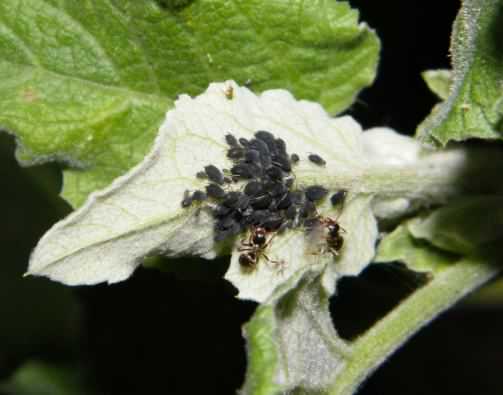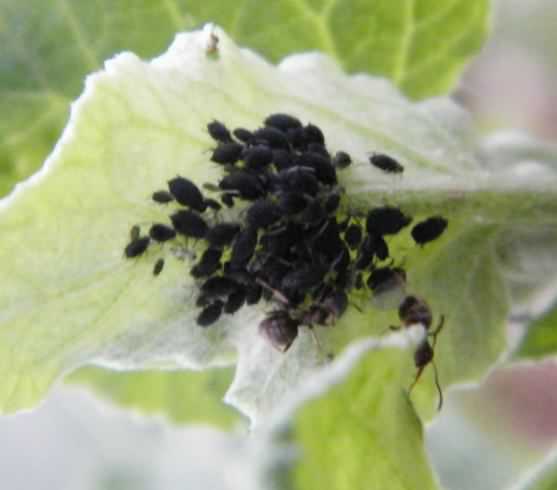
Black Ants "farming" Aphids
Photos ©2011–2025 BCP
Click any photo for a larger image


Black Ants "farming" Aphids
Photos ©2011–2025 BCP
Click any photo for a larger image

Black Bean Aphid - Aphis fabae
Family - Aphididae
Also known as - Black fly, plant lice
Aphids are a group of small sap sucking invertebrates usually regarded as a pest by gardeners and farmers. There are around 4000 species of aphid, of which approximately 250 species are serious pests for agriculture and forestry, each with its own favourite host plants and particular life cycle. Greenfly and Blackfly are the most familiar, but there are also yellow, red, orange and brown aphids. The Black Bean Aphid – A. fabae, commonly known as Blackfly, is 1–3mm (0.04–0.125in) long, pear shaped and matte black in colour, but can also appear dark green or purple. Gregarious, they form large colonies which can cover significant areas of younger stems, undersides of leaves and sometimes flower buds of many garden plants, trees, shrubs and certain vegetables - mainly beans and peas.
The Black Bean Aphid is polyphagous, primary hosts on which the eggs over winter are shrubs such as the Spindle Tree – Euonymus europaeus, or the Viburnum – Viburnum spp.. Its secondary hosts, on which it spends the summer months, include a number of crops including sugar beet, spinach, beans, runner beans, celery, potatoes, sunflowers, carrots, artichokes, tobacco and tomatoes. It colonises many species of cultivated and wild plants showing a preference for Poppies, Burdock, Fat–hen – Chenopodium album, Saltbush – Atriplex rosea, Chamomile – Matricaria chamomilla, Thistles and Docks.
They feed on the sap of their host plants sometimes inflicting considerable damage stunting the plants growth. As they feed, they secrete the plant's sugars as a sticky substance called honeydew which drips onto lower foliage and can often become covered in a sticky black mould. They can also acts as a vector for viruses that cause plant disease. Black Bean Aphid infestations are commonly managed by Common Black Garden Ants which "farm" the aphids and "milk" the sticky honeydew that they produce (see the top photo). Ants will often carry young aphids onto new plants to establish new colonies.
Distributed worldwide the Black Bean aphid may have originated in Europe and Asia. It is found throughout temperate areas of Western Europe, Asia and North America and in the cooler parts of Africa, the Middle East and South America. In the warmer parts of its range, apterous individuals can survive the winter and it may continue to reproduce asexually all year round. During the warmer months aphids give birth to as many as five live young a day so large colonies can develop quickly, however when the colonies become over–populated, they move to different locations by producing winged aphids. Aphids are predated by ladybirds, hoverfly larvae, parasitic wasps, aphid midge larvae, crab spiders, lacewings and some fungi.
Site design ©1999–2025 Brickfields Country Park - Privacy - updated 2nd March 2025